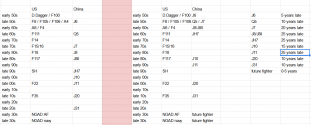by78
General
Please stop quoting that Twitter account. The guy is a stupid fanboy. Ignore anything and everything he claims.
The first is from the movie stealth , the second looks like a bullpup eurofighter, the third looks like sr-71View attachment 85972
no idea what it is
The one in the middle looks similar to XB-70 Vylkyrie airframe configuration with different engine layout.The first is from the movie stealth , the second looks like a bullpup eurofighter, the third looks like sr-71
Yeah. I couldn't think of it . I was only thinking about the eurofighter.The one in the middle looks similar to XB-70 Vylkyrie airframe configuration with different engine layout.
View attachment 85972
no idea what it is

60s, 70s and even 80s were the worst time for china's aerospace sector, as it was lagging so much behind US one technology wise. No Russian input and cultural revolution really didn't help there.
J-11 was is most probably better than first batch of f-15 and 18... but they still build f-15 and f-18 so being late is not that bad at this rate.A little bit of mental gymnastics...
Here's a list of Chinese fighter jets - by the year they first flew.
J6 - 1958
J7 - first flew in 1966 but first local production variant flew a decade later, in 1976.
J8 - first flew in 1969 but again, first actual local production variant flew in 1980.
China/Russia ties and Cultural revolution definitely did a number on China's aerospace sector in that period.
J8II first flew in 1984. Though, of course, it was far from a whole new plane, compared to basic J8.
JH7 first flew in 1988.
J10 first flew in 1998.
J11, the domestically produced variant, first flew in 2003.
J20 first flew in 2011.
J21/31/35 first flew in 2021 though, of course, the first demonstrator plane of that concept flew in 2012.
If trying to roughly separate those by generations/capabilities, we'd get a list like this:
View attachment 86172
First table, left of the red divider column, shows when a certain type entered service. (usually a few years after the first flight)
The table on the right of the red divider shows the chinese planes adjusted for capability, so they match the time period when the US planes had the same capability.
For example, J10, when it entered service in early 00s basically had the same capability as F16 in late 1980s when it comes to air to air. (in air to ground it was even worse but that's another matter)
J20 could also be argued that when it entered service in late 2010s had similar capability as F22 when it reached proper service a decade earlier.
Of course, all these labels are not terribly precise and surely different people would adjust some of these values by 5 or so years in some examples.
Yet, it still shows the progress of china's domestic aerospace sector.
Initially it wasn't behind the US progress that much, in pure year gaps. 5 to 10 years. Of course, back then in the 1950s 10 or even 5 years was A LOT, as aerospace advances moved at a lightning speed.
60s, 70s and even 80s were the worst time for china's aerospace sector, as it was lagging so much behind US one technology wise. No Russian input and cultural revolution really didn't help there.
But we're once again seeing the gap getting smaller. Once the next generation of planes come, the gap may be quite small. Perhaps just 5 years. And unlike in 1950s, 5 years would be relatively speaking an even smaller gap today.
What is apparent, though, is that developing new generations takes longer and longer. Whether china has shrunk that particular gap compared to US remains to be seen. Certainly, next gen could already be in development. With it taking flight just a few years after the US counterparts.
I quite liked his metaphor that flying future manned fighters will become less and less like first person shooters and more and more like turn based RTS where you boss your AI controlled UAVs around to counter the other guy.a video from XiYazhou on NGAD and just trending of 6th gen aircraft. I think this is quite helpful compared to other videos he has made. Talked a lot of about AI, manned/unmanned teaming in 6th generation warfare. He talked about developing all aspect stealth in 6th gen aircraft. He talked about the greater range requirement of 6th generation aircraft, but not necessarily better maneuverability. It would seem to me that's why Shilao has talked about J-20B with the second pilot and improved electronics as factors that make it 5.5 generation. Whether that would be communication technology with drones, having latest computing power, sensor fusion, commanding loyal wingman and other things.
